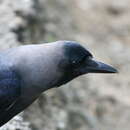en
names in breadcrumbs


Introduced breeder.
House Crows (Corvus splendens) are very abundant throughout their native range in South Asia, as well as in much of their introduced range (see below), although concerns about impacts on local ecosystems and agriculture and possible threats to human health have led to systematic control efforts in some parts of the non-native range. Wherever there are human settlements in the (mainly) lowlands of the Indian subcontinent, from small villages to large cities, House Crows are there, scavenging food of all kinds wherever they can find it. The House Crow is among the most familiar and conspicuous of Indian birds.
The native range of the House Crow is South Asia, extending throughout Pakistan, Bangladesh, India, and Sri Lanka, including the Maldive and Laccadive Islands, and the Himalayan foothills of Nepal and Bhutan eastward through Burma to extreme southern China (Yunnan). It occurred historically in southwestern Thailand. House Crows have been introduced (in some cases intentionally, but mainly by hitchiking on ships) widely around the Indian Ocean and beyond. Colonies have been established in the Middle East in Iran, Kuwait, Saudi Arabia, Bahrain, United Arab Emirates, Oman, Yemen, Jordan, and Israel; in East Africa, in Egypt, Sudan, Djibouti, Eritrea, Somalia, Kenya, Tanzania, and Mozambique; on Indian Ocean islands, including the Seychelles and Mauritius; and in Southeast Asia, on the Andaman Islands, peninsular Malaysia, Singapore, and possibly Sumatra and northern Borneo. Over the years, presumed ship-transported individuals have shown up in Australia, Hong Kong (where the species may now be established), Japan, the United States (New Jersey, South Carolina, Florida), Gibralter, Morocco, France, Poland, Hungary, Denmark, the Netherlands, Ireland, and Chile.
(Madge and Burn 1994 and references therein; dos Anjos 2009 and references therein)